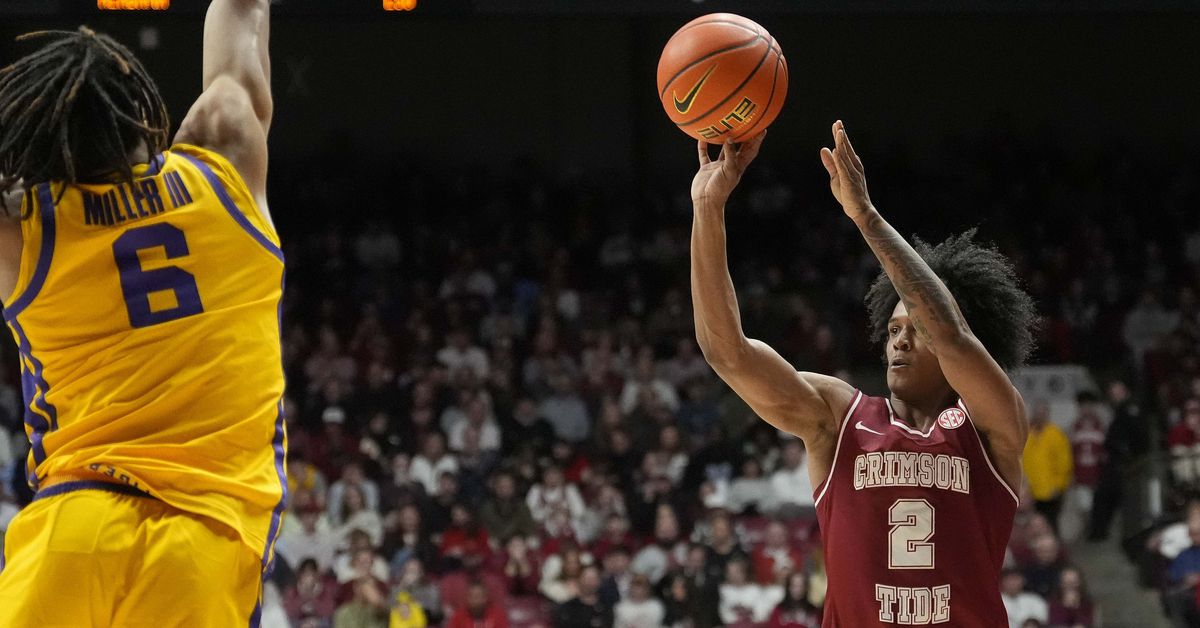
Happy Thursday, everyone. Alabama opens up the most brutal season-ending stretch in the nation with the first of a bookend pair against top-ranked Auburn. Aden Holloway will be at the center of this one, and one key difference between Bruce Pearl and Nate Oats may well be the difference in his play.
Holloway’s shooting stroke went cold as a freshman at Auburn last year, for a long-enough stretch that AU head coach Bruce Pearl called for he and other struggling outside shooters to be more selective. That’s not to say Pearl’s relationship with Holloway went sour, but asking a shooter to be more judicious about shooting can undermine confidence. Holloway’s 3-point shot is the primary asset he brings. It’s the heart of why he was a McDonald’s All-American as a recruit. So it’s little wonder Holloway found himself attracted to Alabama, where Oats’ guns don’t come with holsters, as a transfer destination.
A year after being asked to find his rhythm on fewer shots, Holloway is now under a directive to launch every open 3-pointer he can. And he’s draining them in bunches: a scorching-hot 26 of 52 (50%) since SEC play began on Jan. 4.
Yeah, Auburn’s bench might in for a stare-down or two.
“Any of those that he gets open, we want him to shoot,” Oats said. “We’re just trying to pump him full of confidence and tell him he cannot pass up any open looks period at any point, and we’ve got to try to find him some more shots.”
Entering Tuesday, Holloway was shooting 50% from 3-point range and 55.4% from the floor. Although All-American Mark Sears still leads the Crimson Tide in scoring at 17.5 points per game in league play, Holloway is coming off the sideline for 13.
As a freshman at Auburn, Holloway was an All-SEC Freshman selection, but he was shooting 31.8% from the field and 30.2% beyond the arc in comparison.
If there was ever a mild criticism to have of Nick Saban, it’s that he seemed to sometimes preach ball security to the point that his quarterbacks became too risk averse. A great shooter needs to feel confident to pull the trigger, and keep pulling it, even if the first couple don’t fall. Nate Oats will bench a good shooter for not shooting the ball when he’s open, which is exactly the type of mentality that has allowed Aden to flourish. Under Nate, this kid has turned into a bucket.
It’s great that Aden was able to get out from under such a regime and find a coach who could maximize him. I guess this is what the portal is for.
Alabama holds some advantages in this one.
Alabama’s offensive rebounding percentage is 37%, ranked 16th nationally. Meanwhile, Auburn has grabbed offensive rebounds at a rate of 36.2%, ranked 25th.
The Crimson Tide is also ahead of the Tigers in two-point shooting percentage; Alabama makes 60.8% of its two-point attempts, and that’s second-best in the nation. Auburn makes 56.6%, ranked 22nd. That’s certainly a good number for the Tigers, but the Crimson Tide is one of the most efficient and best with its shots inside the arc.
Lastly, Alabama holds an edge in effective field-goal percentage. What does that mean? Let KenPom explain: “This differs from conventional field goal percentage by taking into account the extra value of a made 3-pointer.”
It should be a close, hard fought battle.
Greg Byrne suggests a forfeit for field or court storming, which feels like something that will never, ever happen.
“I’m not overly optimistic and understand it’s not a popular opinion in a lot of people’s view,” Byrne said. “I’ll get criticized for it, and that’s okay. I do believe in it. If somebody can come up with something that’s a better idea that does not include that, I’m all for it.
“I’m not saying that’s the only possible way. I’m convinced, in my own simple mind, that that would be something that would stop it.”
Instead of rushing the playing surface, Greg Byrne said fans should instead have a good time in the stands. But he also suggested letting the players leave before allowing those in attendance to celebrate on the field or court, pointing again to the safety side of his argument.
“Let’s celebrate up in the stands,” Byrne said. “Let’s have a great environment. I’d even be fine if you say, let’s give it three minutes to get the team off the field. Then, if they want to come down and celebrate, great.”
Last, Stewart Mandel acknowledged that the SEC and Big Ten do in fact hold all of the college football cards.
In typically weird CFP fashion, in late 2023, its media consultants reached an agreement in principle with ESPN on a six-year, $7.8 billion extension before the conferences had yet agreed on “any aspects of the format,” as The Athletic reported at the time. Those meetings finally commenced around this time last year, at which point the Big Ten and SEC walked into the room and made a bunch of big asks, some of which got tabled for the time being (14 teams?) but much of which got codified. Those leagues got substantially bigger revenue cuts, but also, they ensured future format changes won’t require unanimity.
The Big Ten and SEC can basically say, this is how we’re doing things now.
So, I will rephrase your question in the past tense: Why did the ACC and Big 12 voluntarily give up control of the CFP? And I think you answered it yourself: the “we’ll take our ball and go home” threat. You cannot have a credible Playoff without the Big Ten and SEC. You just can’t. And most of the sport’s biggest brands are in those two leagues, so an ACC/Big 12/G5 Playoff would net a fraction of the $7.8 billion.
That’s about it for now. Have a great day.
Roll Tide.







